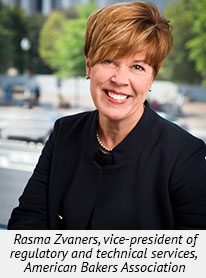From recycling to water reduction, bakery operations always are searching for new ways to cut down on waste. Measuring results can be complicated though, and making substantial strides without the proper guidance is even more challenging.
For bakers looking to set up their first sustainability initiative, the Energy Star program by the U.S. Environmental Protection Agency (E.P.A.) offers operations the industry-related resources and benchmarking tools needed to create an effective energy management system and become Energy Star certified.
“There are many ways to look at energy efficiency, and it can be based on the goals of each baking company,” said Rasma Zvaners, vice-president of regulatory and technical services at the American Bakers Association. “The Energy Star program is one of the tools at the industry’s disposal.”
To get started, Ms. Zvaners, who will speak about the Energy Star program at this year’s International Bakery Industry Exposition (IBIE) being held Sept. 7-11, recommended that bakers review the guide Energy Efficiency Improvement and Cost Saving Opportunities for the Baking Industry developed by the Ernest Orlando Lawrence Berkeley National Laboratory as part of an E.P.A. and A.B.A. partnership. The resource offers insights on general best practices, improvement opportunities, technologies and environmental targets.
 “This is a great resource for any baker interested in learning where to start,” Ms. Zvaners noted.
“This is a great resource for any baker interested in learning where to start,” Ms. Zvaners noted.
Once a bakery has committed to reducing its output, Energy Star recommends that manufacturers take five steps to build a management program. The first step includes identifying operational gaps through assessment tools for single plant and corporate programs. After any weak spots are identified, bakeries can build a roadmap for success with the Energy Star Guidelines for Energy Management where operators can discover resources that aid performance.
The third and fourth steps include building an energy team and raising awareness among site employees. “In working with the A.B.A. members over the past years on this program, the biggest challenge that arises is ensuring that the company from the top down is committed to energy reduction initiatives,” Ms. Zvaners said. “It takes everyone from the bakery floor to top management to embrace the effort.”
To get all employees on board and engaged with the initiative, Energy Star recommended hanging up customized educational posters, creating energy efficiency competitions amongst teams and sharing updates on goals.
Once bakeries have the basics of their program in motion, the final step they need to take is getting Energy Star certified. Select plants located in the United States can earn the distinction by achieving an Energy Star score of 75 or higher, which is evaluated by using the Energy Performance Indicator for bread and roll bakeries or cookie and cracker bakeries. The organization calculates a site’s performance by gathering data on its total energy use, weather conditions, operations and products.
Bakeries can also take the A.B.A. Energy Star Challenge, a voluntary program where an operation commits to a 10% energy intensity reduction over five years.
“We’ve found that many of our bakers are able to meet this challenge in less time,” Ms. Zvaners noted.
To learn more about energy reduction strategies and challenges, bakers can attend the IBIE education session Energy Efficiency Improvement and Cost Savings Opportunities for Baking led by Ms. Zvaners and Walt Tunnessen, national program manager, Energy Star, E.P.A.




